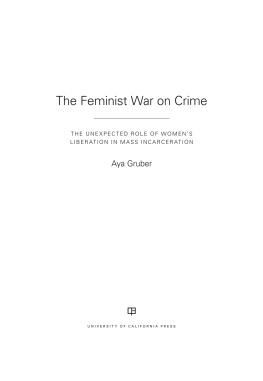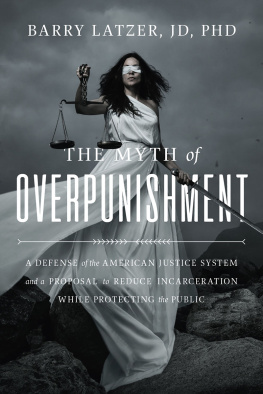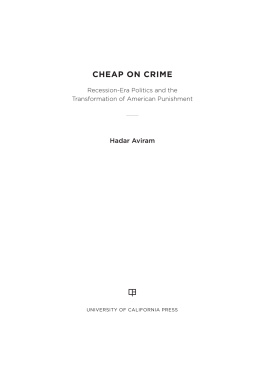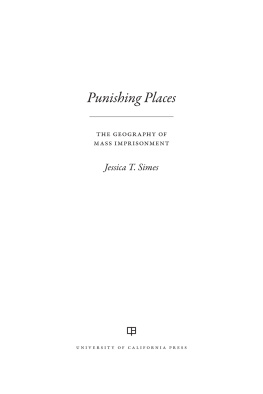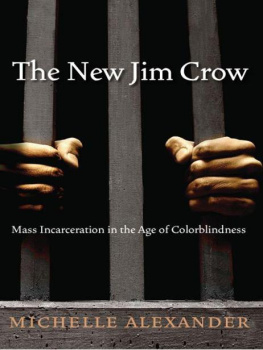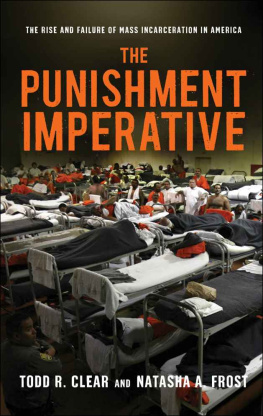RACE,
INCARCERATION,
AND AMERICAN
VALUES
RACE,
INCARCERATION,
AND AMERICAN
VALUES
Glenn C. Loury
Based on the 2007 Tanner Lectures on
Human Values at Stanford
A Boston Review Book
THE MIT PRESS Cambridge, Mass. London, England
Copyright 2008 Massachusetts Institute of Technology
All rights reserved. No part of this book may be reproduced in any form by any electronic or mechanical means (including photocopying, recording, or information storage and retrieval) without permission in writing from the publisher.
MIT Press books may be purchased at special quantity discounts for business or sales promotional use. For information, please e-mail or write to Special Sales Department, The mit Press, 55 Hayward Street, Cambridge, MA 2142.
This book was set in Adobe Garamond by Boston Review and was printed and bound in the United States of America.
Loury, Glenn C.
Race, incarceration, and American values / Glenn C. Loury ; with Pamela Karlan, Loc Wacquant, and Tommie Shelby.
p. cm.
A Boston Review book.
ISBN 978-0-262-12311-2 (hardcover : alk. paper)
1. Prisons and race relationsUnited States. 2. PrisonersUnited States. 3. Race discriminationUnited States. 4. ImprisonmentUnited States. 5. Criminal justice, Administration ofUnited States. 6. Justice, Administration ofUnited States. 7. Crime and raceUnited States. 8. United StatesRace relations. I. Title.
HV6197.U5L68 2008
365'.608996073dc22
2008022921
10 9 8 7 6 5 4 3 2 1
For my grandchildren
I
Race, Incarceration, and American Values
THE EARLY 1990S WERE THE AGE OF drive-by shootings, drug deals gone bad, crack cocaine, and gangsta rap. Between 1960 and 1990, the annual number of murders in New Haven rose from 6 to 31, the number of rapes from 4 to 168, the number of robberies from 16 to 1,784all this while the citys population declined by 14 percent. Crime was concentrated in central cities: in 1990, two-fifths of Pennsylvanias violent crimes were committed in Philadelphia, home to one-seventh of the states population. The subject of crime dominated American domestic-policy debates.
Most observers at the time expected things to get worse. Consulting demographic tables and extrapolating trends, scholars and pundits warned the public to prepare for an onslaught, and for a new kind of criminalthe anomic, vicious, irreligious, amoral, juvenile super predator. In 1996, one academic commentator predicted a bloodbath of juvenile homicides in 2005.
And so we prepared. Stoked by fear and political opportunism, but also by the need to address a very real social problem, we threw lots of people in jail, and when the old prisons were filled we built new ones.
But the onslaught never came. Crime rates peaked in 1992 and have dropped sharply since. Even as crime rates fell, however, imprisonment rates remained high and continued their upward march. The result, the current American prison system, is a leviathan unmatched in human history.
According to a 2005 report of the International Centre for Prison Studies in London, the United Stateswith 5 percent of the worlds populationhouses 25 percent of the worlds inmates. Our incarceration rate (714 per 100,000 residents) is almost 40 percent greater than those of our nearest competitors (the Bahamas, Belarus, and Russia). Other industrial democracies, even those with significant crime problems of their own, are much less punitive: our incarceration rate is 6.2 times that of Canada, 7.8 times that of France, and 12.3 times that of Japan. We have a corrections sector that employs more Americans than the combined work forces of General Motors, Ford, and Wal-Mart, the three largest corporate employers in the country, and we are spending some $200 billion annually on law enforcement and corrections at all levels of government, a fourfold increase (in constant dollars) over the past quarter century.
Never before has a supposedly free country denied basic liberty to so many of its citizens. In December 2006, some 2.25 million persons were being held in the nearly 5,000 prisons and jails that are scattered across Americas urban and rural landscapes. One-third of inmates in state prisons are violent criminals, convicted of homicide, rape, or robbery. But the other two-thirds consist mainly of property and drug offenders. Inmates are disproportionately drawn from the most disadvantaged parts of society. On average, state inmates have fewer than eleven years of schooling. They are also vastly disproportionately black and brown.
How did it come to this? One argument is that the massive increase in incarceration reflects the success of a rational public policy: faced with a compelling social problem, we responded by imprisoning people and succeeded in lowering crime rates. This argument is not entirely misguided. Increased incarceration does appear to have reduced crime somewhat. But by how much? Estimates of the share of the 1990s reduction in violent crime that can be attributed to the prison boom range from 5 percent to 25 percent. Whatever the number, analysts of all political stripes now agree that we long ago entered the zone of diminishing returns. The conservative scholar John Dilulio, who coined the term super predator in the early 1990s, was by the end of that decade declaring in The Wall Street Journal, Two Million Prisoners Are Enough. But there was no political movement for getting America out of the mass-incarceration business. The throttle was stuck.
A more convincing argument is that imprisonment rates have continued to rise while crime rates have fallen because we have become progressively more punitive: not because crime has continued to explode (it hasnt), not because we made a smart policy choice, but because we have made a collective decision to increase the rate of punishment.
One simple measure of punitiveness is the likelihood that a person who is arrested will be subsequently incarcerated. Between 1980 and 2001, there was no real change in the chances of being arrested in response to a complaint: the rate was just under 50 percent. But the likelihood that an arrest would result in imprisonment more than doubled, from 13 to 28 percent. And because the amount of time served and the rate of prison admission both increased, the incarceration rate for violent crime almost tripled, despite the decline in the level of violence. The incarceration rate for nonviolent and drug offenses increased at an even faster pace: between 1980 and 1997 the number of people incarcerated for nonviolent offenses tripled, and the number of people incarcerated for drug offenses increased by a factor of eleven. Indeed, the criminal-justice researcher Alfred Blumstein has argued that none of the growth in incarceration between 1980 and 1996 can be attributed to more crime.
The growth was entirely attributable to a growth in punitiveness, about equally to growth in prison commitments per arrest (an indication of tougher prosecution or judicial sentencing) and to longer time served (an indication of longer sentences, elimination of parole or later parole release, or greater readiness to recommit parolees to prison for either technical violations or new crimes).
This growth in punitiveness was accompanied by a shift in thinking about the basic purpose of criminal justice. In the 1970s, the sociologist David Garland argues, the corrections system was commonly seen as a way to prepare offenders to rejoin society. Since then, the focus has shifted from rehabilitation to punishment and stayed there. Felons are no longer persons to be supported, but risks to be dealt with. And the way to deal with the risks is to keep them locked up. As of 2000, thirty-three states had abolished limited parole (up from seventeen in 1980), twenty-four states had introduced three-strikes laws (up from zero), and forty states had introduced truth-in-sentencing laws (up from three). The vast majority of these changes occurred in the 1990s, as crime rates fell.


